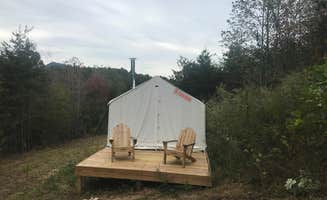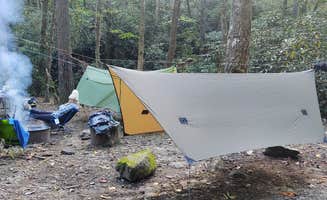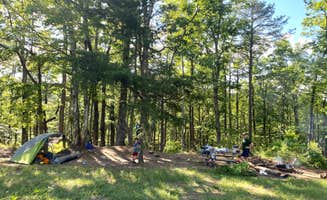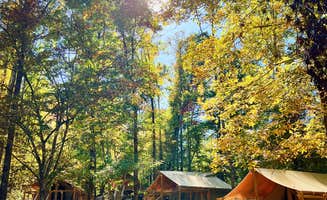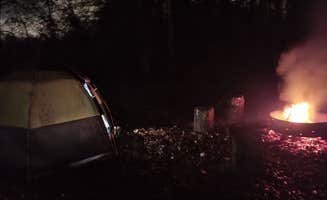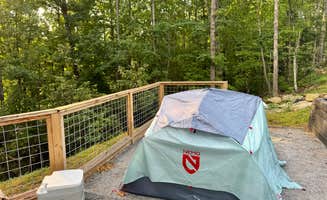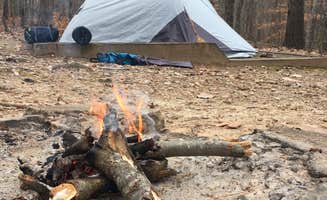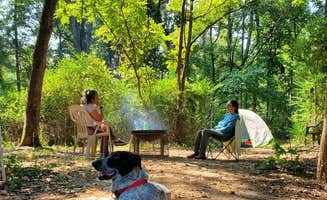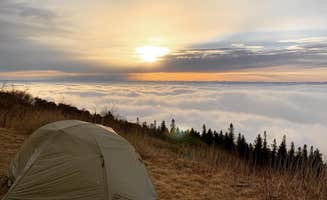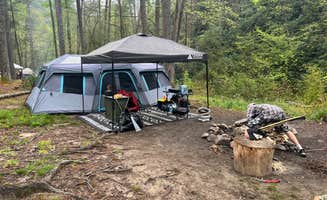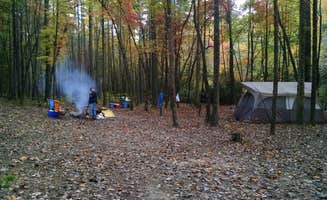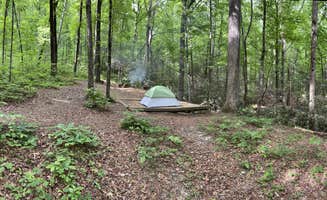Tent campsites near Forest City, North Carolina offer diverse terrain from riverside settings to mountain backpacking sites, with elevations ranging from 800 to 1,200 feet. Primitive camping options typically see summer temperatures reaching 85-90°F, while spring and fall camping provides more moderate 60-75°F temperatures. Many sites feature distinct habitats along creeks and rivers that support local wildlife including white-tailed deer and numerous bird species.
What to do
**Riverside exploration: Water access varies significantly between sites, with Primitive Camping By the Creek offering immediate creek frontage. "The creek is right beside the camp. Nice and secluded. Firewood was provided," notes Tim W., highlighting the convenience of water proximity for both recreation and practical needs.
**Day hiking: Trails connect many backcountry sites to waterfalls and viewpoints. At Crowders Mountain State Park Campground, Lisa L. reports, "We really enjoyed all of the different hikes and the lake as well as the hike to the top of the mountain. The hike to the top was a little strenuous for smaller kids." Most trails range from 1-5 miles with moderate to steep sections.
**Rock climbing: Several locations offer natural climbing features with varying difficulty levels. "My brother and I spent the day rock climbing. It was his first time climbing, and we were able to set up some beginner-friendly routes," shares Les R., pointing out the accessibility for novice climbers at Crowders Mountain.
What campers like
**Privacy between sites: Many backcountry locations provide substantial separation between campers. At Jones Gap State Park Campground, Emily S. explains, "Unlike other state park campgrounds, each spot is about a quart mile from the next, so you feel like you have the mountain to yourself." Most sites require at least short walks from parking areas.
**Natural soundscapes: Creek and river sounds enhance the camping experience at numerous locations. "The river is a great soundtrack for a nights sleep," reports Kevin G. about Jones Gap's site #10. Water features provide both ambient noise and recreational opportunities.
**Hammock options: Trees at most sites support hammock camping setups. At Catawba River, Todd S. observed, "So many nice little places to hang a hammock and relax. The sites down by the water are awesome." Tree spacing typically ranges from 10-20 feet apart at mature sites.
What you should know
**Water source distances: Filterable water may require significant hiking from your campsite. At Little River Backcountry Campground — South Mountains State Park, Danielle T. notes, "From the Little River campground, the closest water source is a creek 0.6 miles (1.2 miles round trip) away - filter it - the walk back to camp is a steep uphill." Plan accordingly for water needs.
**Tent pad challenges: Many sites feature difficult ground conditions for tent setup. "The sites are a bit difficult to pitch on, due to the abundance of roots, hardpan earth, and slope, but you'll find a spot," explains Glacia C. about Jacob Branch sites. Most tent pads measure approximately 10x10 feet.
**Food storage requirements: Bear activity necessitates proper storage precautions. "Bear box! Woot!!" exclaims Glacia C. about Jacob Branch Backcountry Sites, indicating the importance of this amenity. Sites without bear boxes require food hanging at least 10 feet high and 4 feet from tree trunks.
Tips for camping with families
**Choose accessible sites: Some locations offer easier approaches for families with children. "This is a brand new tent and cabin campground built by Duke Energy and run by McDowell county on Lake James... Many of the sites are a short walk from the car which affords privacy," explains Robin B. about Black Bear Campground.
**Stream proximity: Water features provide natural entertainment for children. "The campsite has a pretty creek and forest. On the campsite there is a lot of firewood to use, in a shed to keep it dry," notes Reid about Primitive Camping By the Creek, highlighting the dual benefits of water access and amenities.
**Select kid-appropriate hikes: Trail difficulty varies significantly across the region. "Shinny Creek: Perfect trip if you have kids... It's only a bit over a mile to these four sites nestled by a stream. Clear, flat sites," recommends Glacia C., pointing out the gentler terrain suitable for younger hikers.
Tips for RVers
**Limited RV options: Most primitive sites in the region cannot accommodate RVs. "This is a brand new tent and cabin campground... All sites have tent pads and 2 parking spots," explains Robin B. about Black Bear Campground, highlighting the tent-focused nature of most facilities.
**Consider alternative bases: Some locations offer cabin options alongside tent sites. "Camped at Wilderness Cove in August 2020 for 2 nights. Very clean, small, quiet campground. Tents only, they do have some cabins for rent," reports Tammie S. about Wilderness Cove Campground | Outdoor Adventure Retreats, noting the accommodation limitations.
**Parking constraints: Vehicle size restrictions apply at most primitive camping areas. "The sites are large and have varying degrees of privacy," notes Sara M. about Jones Gap, though most parking areas limit vehicle length to under 20 feet, making larger RVs impractical.


